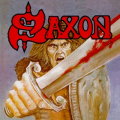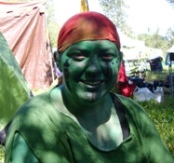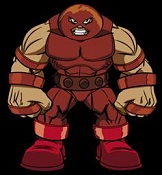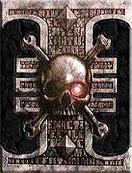Hand Drumming
Moderator: Belegarth: Forum Moderators
36 posts
• Page 1 of 1
Hand Drumming
There is a lot of hand drumming at events. I have not seen any info dedicated to it on the boards, so here is a rough guide for people that want to learn more about it. I will write the guide with hand drums in mind, although a some of the principals can carry over to other instruments. I will do it in three sections: instruments, tones, and timing.
Instruments
There are more names for hand drums in the world than there are fighters in our sport. That being said, there are some commonly used names that cover most of what is readily available to people online and in stores in the US.
The Djembe: A larger drum, originated in West Africa. They are usually carved out of wood and have a rope tightened skin head. These are great drums to learn on as they have a larger head and therefore make it easier for the player to get proper tones out of.
Djembe on Lark In The Morning
The Doumbek: A smaller drum, sometimes called a darbuka, originated in what is now Turkey. These days, they are a metal frame with a plastic head. This is the drum most commonly associated with belly dance. It does have a smaller head than the djembe, so can be a bit tougher to get pure bass tones out of, but no hand drum is necessarily hard to play. These also have amazing high notes.
Doumbek on Musician's Friend
The Conga: This is a tall slender hand drum that originated from Central Africa, later perfected in Cuba. They are often played in pairs, but sound fine by themselves as well. These drums have a cleaner sound than the first two and are used more as accompaniment as a result. They don't have as awesome of a lower register as the djembe, but embellishment sounds good on them thanks to how clean they are.
Conga on Musician's Friend
The Bongo: Always played as a pair, these are very small hand drums that experts believe originated in hippie basements. They really aren't great for drum circles at events, but they are a good addition if you already have a lot of big drums. Oh, and they actually came from Cuba.
Bongos on Musician's Friend
Other Auxiliary Percussion: Claves, Castanets, Bells, Shakers, etc. There are myriad other little instruments that are a blast to add to drum circles, and the best part is, there are always super cheap versions, or DIY versions. My current favorite is my new Wah Wah Tube from Meinl. Point is, there are lots of options, go into a shop and play with stuff.
Tones
There are three main sounds you can get out of hand drums. If you learn from a traditional African drummer, they will call them Du (pronounced doo), Dun (doon), and Ta (like "thanks" in Australia). Du (or Gu) is the near-flat-palmed, fingers together hit to the center (or just off center) of the drum for a loud bass sound. Dun (or Gun) is also called the tone sound, or vocal sound, and is a hit near the edge, still with the fingers together. Ta (or Pa) is the slap to the edge, with the fingers apart, to produce a very high pitched slap sound.
Demonstration
Timing
This video is a fairly good example of what you should be trying to do when you count. Basically, a lot of what gets played in drum circles is slow. Our brains have a hard time keeping a beat slower than about 60bpm, so what you need to do is subdivide. Instead of thinking "1 2 3 4" in your head, think "1and2and3and4". If you keep a subdivided count going in your head, you can hit a note on beat 1 only, then hit beat 1 again perfectly in time 2 bars later because in your head, the beat never stopped. Watch the video, hopefully what I said and what he says makes some sense.
Thats basically it. I wanted to have a section on rhythms, but it is hard to convey in text, and I can't find good videos. Two things to keep in mind when playing in a group though.
1: Not everyone can solo at the same time. Triple forte flam taps sound cool, but not when six different people are trying to do them at the same time. When you start a drum circle, have one person lay down a very simple pattern to start from using the bass and tone. Once everyone is in, try going around the circle to solo, or try having some people play the bass part, some play the high part. Play around with it, but make sure that bass pattern is always there as a foundation, otherwise its not drumming, its racket.
2: Dynamics. This is a fancy music word for how loud you are. Do not try to kill the drum. Play to blend with the rest of the group. Getting loud in a solo or for small embellishments is fine, but if everyone competes to be the loudest the whole time, it is again just a racket, and afterward your hands hurt like a *.
So there ya have it. I hope it is some help to people.
Please feel free to ask questions.
Peace
Instruments
There are more names for hand drums in the world than there are fighters in our sport. That being said, there are some commonly used names that cover most of what is readily available to people online and in stores in the US.
The Djembe: A larger drum, originated in West Africa. They are usually carved out of wood and have a rope tightened skin head. These are great drums to learn on as they have a larger head and therefore make it easier for the player to get proper tones out of.
Djembe on Lark In The Morning
The Doumbek: A smaller drum, sometimes called a darbuka, originated in what is now Turkey. These days, they are a metal frame with a plastic head. This is the drum most commonly associated with belly dance. It does have a smaller head than the djembe, so can be a bit tougher to get pure bass tones out of, but no hand drum is necessarily hard to play. These also have amazing high notes.
Doumbek on Musician's Friend
The Conga: This is a tall slender hand drum that originated from Central Africa, later perfected in Cuba. They are often played in pairs, but sound fine by themselves as well. These drums have a cleaner sound than the first two and are used more as accompaniment as a result. They don't have as awesome of a lower register as the djembe, but embellishment sounds good on them thanks to how clean they are.
Conga on Musician's Friend
The Bongo: Always played as a pair, these are very small hand drums that experts believe originated in hippie basements. They really aren't great for drum circles at events, but they are a good addition if you already have a lot of big drums. Oh, and they actually came from Cuba.
Bongos on Musician's Friend
Other Auxiliary Percussion: Claves, Castanets, Bells, Shakers, etc. There are myriad other little instruments that are a blast to add to drum circles, and the best part is, there are always super cheap versions, or DIY versions. My current favorite is my new Wah Wah Tube from Meinl. Point is, there are lots of options, go into a shop and play with stuff.
Tones
There are three main sounds you can get out of hand drums. If you learn from a traditional African drummer, they will call them Du (pronounced doo), Dun (doon), and Ta (like "thanks" in Australia). Du (or Gu) is the near-flat-palmed, fingers together hit to the center (or just off center) of the drum for a loud bass sound. Dun (or Gun) is also called the tone sound, or vocal sound, and is a hit near the edge, still with the fingers together. Ta (or Pa) is the slap to the edge, with the fingers apart, to produce a very high pitched slap sound.
Demonstration
Timing
This video is a fairly good example of what you should be trying to do when you count. Basically, a lot of what gets played in drum circles is slow. Our brains have a hard time keeping a beat slower than about 60bpm, so what you need to do is subdivide. Instead of thinking "1 2 3 4" in your head, think "1and2and3and4". If you keep a subdivided count going in your head, you can hit a note on beat 1 only, then hit beat 1 again perfectly in time 2 bars later because in your head, the beat never stopped. Watch the video, hopefully what I said and what he says makes some sense.
Thats basically it. I wanted to have a section on rhythms, but it is hard to convey in text, and I can't find good videos. Two things to keep in mind when playing in a group though.
1: Not everyone can solo at the same time. Triple forte flam taps sound cool, but not when six different people are trying to do them at the same time. When you start a drum circle, have one person lay down a very simple pattern to start from using the bass and tone. Once everyone is in, try going around the circle to solo, or try having some people play the bass part, some play the high part. Play around with it, but make sure that bass pattern is always there as a foundation, otherwise its not drumming, its racket.
2: Dynamics. This is a fancy music word for how loud you are. Do not try to kill the drum. Play to blend with the rest of the group. Getting loud in a solo or for small embellishments is fine, but if everyone competes to be the loudest the whole time, it is again just a racket, and afterward your hands hurt like a *.
So there ya have it. I hope it is some help to people.
Please feel free to ask questions.
Peace
Oh, he's very popular Ed. The sportos, the motorheads, geeks, sluts, bloods, waistoids, dweebies, * - they all adore him. They think he's a righteous dude.
-

Saxon - Berserker

- Posts: 841
- Joined: Mon Mar 29, 2004 1:27 am
- Location: Portland, OR
- Started Fighting: 01 May 2004
- Realm: Whatever Portland is called this year
- Favorite Fighting Styles: Sword and board or beer and drum.
Re: Hand Drumming
Thanks for the information and the links.
Derian, is this worthy of a sticky as a tut?
Derian, is this worthy of a sticky as a tut?
-

Tiberius Claudius - Hero

- Posts: 1431
- Joined: Wed Aug 12, 2009 10:50 pm
- Location: St. George, UT
- Started Fighting: 20 May 2009
- Realm: An Tir Dearg - Realm Leader
- Unit: War Wolves of An Tir Dearg
- Favorite Fighting Styles: S&B, spear, longsword
Re: Hand Drumming
At least in the south east portion of Belegarth, we have a very talented group of hand drummers. A few music majors, and a good number of band members. Most importantly (and for drum circles in general) is the group dynamic we usually play with. So, a few tips:
1) Dont Overplay: In dynamics and rhythms, overplaying is going to do some damage to a drum circle. If you can solo, by all means: do. If you over-extend your abilities and completely mess up the groove, well... dont do that. A good solo doesnt need ten-thousand notes: just play a cool rhythm on top of of whats going on. As far as dynamics go, its no fun for the little guy if you are drowning him out all the time
2) Drum Circle Mentality: When you drum at events, it is seldom you play alone (at least for a long period). Keep your fellow players in mind, and try and build your beats up using everyone available. The lower-toned drums generally set the beat, with higher-toned drums providing fill and the off and inner beats. If you are playing a djembe that can shake the nails out of a wall, hold the beat and let the more piercing drums go crazy. From what ive seen, you can easily just ask to switch drums at some point, and get your chance to go off.
3) DYNAMICS: This one I see the most trouble with at a Belegarth drum circle. Using a variety of force on your drum adds contrast to a jam, and lets you play the same beat longer without growing stale. You dont always have to play as loud as possible. Try playing soft as you can sometimes. Better yet: see if the entire circle can rise and fall in dynamic throughout the jam.
4)Take charge: As with pretty much every group ever, things tend to work better with people leading things. Dont be afraid to step up during a circle and try and teach people a quick and easy groove. Also, it really boosts circle morale when someone comminucates with the performers. I personally like going around at some point every jam and allowing each player to solo, making sure the rest quiet down so the soloist can be heard. Also, it adds alot when we stop a groove together (One, Two, Ready, And, DONE!). Even if you arent comfortable jumping into the lead spot, any sort of communication goes yards.
1) Dont Overplay: In dynamics and rhythms, overplaying is going to do some damage to a drum circle. If you can solo, by all means: do. If you over-extend your abilities and completely mess up the groove, well... dont do that. A good solo doesnt need ten-thousand notes: just play a cool rhythm on top of of whats going on. As far as dynamics go, its no fun for the little guy if you are drowning him out all the time
2) Drum Circle Mentality: When you drum at events, it is seldom you play alone (at least for a long period). Keep your fellow players in mind, and try and build your beats up using everyone available. The lower-toned drums generally set the beat, with higher-toned drums providing fill and the off and inner beats. If you are playing a djembe that can shake the nails out of a wall, hold the beat and let the more piercing drums go crazy. From what ive seen, you can easily just ask to switch drums at some point, and get your chance to go off.
3) DYNAMICS: This one I see the most trouble with at a Belegarth drum circle. Using a variety of force on your drum adds contrast to a jam, and lets you play the same beat longer without growing stale. You dont always have to play as loud as possible. Try playing soft as you can sometimes. Better yet: see if the entire circle can rise and fall in dynamic throughout the jam.
4)Take charge: As with pretty much every group ever, things tend to work better with people leading things. Dont be afraid to step up during a circle and try and teach people a quick and easy groove. Also, it really boosts circle morale when someone comminucates with the performers. I personally like going around at some point every jam and allowing each player to solo, making sure the rest quiet down so the soloist can be heard. Also, it adds alot when we stop a groove together (One, Two, Ready, And, DONE!). Even if you arent comfortable jumping into the lead spot, any sort of communication goes yards.
Consider Gold. How is a metal that serves no true purpose the cause of so much strife?
-

Adison - Recruit
- Posts: 15
- Joined: Wed Mar 28, 2007 10:57 pm
- Location: Auburn
- Started Fighting: 0- 8-2006
- Realm: Ravens Feast
- Unit: Templar Draconis Kestevara
- Favorite Fighting Styles: Unarmed
Re: Hand Drumming
I cannot emphasize this enough, Belegarth:
If you can, do. If you can't, don't.
If you can, do. If you can't, don't.
-

Spike - Grizzled Veteran

- Posts: 3254
- Joined: Sat Nov 22, 2003 3:52 am
- Location: Portland, OR
- Started Fighting: 9- 0-2003
- Realm: Pyke
- Unit: Horde
- Favorite Fighting Styles: Spear
Re: Hand Drumming
Here's something useful: I hope he chokes on a turkey bone.
Derian, can these posts be deleted please?
Derian, can these posts be deleted please?
-

Tiberius Claudius - Hero

- Posts: 1431
- Joined: Wed Aug 12, 2009 10:50 pm
- Location: St. George, UT
- Started Fighting: 20 May 2009
- Realm: An Tir Dearg - Realm Leader
- Unit: War Wolves of An Tir Dearg
- Favorite Fighting Styles: S&B, spear, longsword
Re: Hand Drumming
Tiberius Claudius wrote:Here's something useful: I hope he chokes on a turkey bone.
Derian, can these posts be deleted please?
Seconded. There's some good info in here.
Knight of Grond
Palatine of the Sons of Sylas
"But in life, the young king becomes a tyrant, and leads his people to war."
Palatine of the Sons of Sylas
"But in life, the young king becomes a tyrant, and leads his people to war."
-

Caleidah - Boo Radley
- Posts: 2055
- Joined: Sun Jan 04, 2009 11:36 pm
- Location: Central IL
- Started Fighting: 03 Jan 2009
- Realm: Grond
- Unit: Sons of Sylas
- Favorite Fighting Styles: Boot and Bottle
Re: Hand Drumming
Focus boys, focus.
Adisons pearls of wisdom part 2:
1) FOCUS: Make sure to keep your head in the game at all times. Think about the music you are playin. This is a hard one, especially for them long jams, but a little concentration keeps you from slipping, and you will probably play better too.
2) The spirits will get ya: When you are playing at a drum circle, you will usually get offered plenty to drink. Enjoy yourself, but if ya get a bit to schmamered, it might be time to back out. You lose alot of rhytmic clarity with each drink, and eventually even the heartiest of livers will fail and you demolish the circle.
3) Contemporary meets modern: People love to hear songs they know. If you and your guitarist buddy can play Mary Janes last dance, go for it. People love that, but dont play it like tom petty. A good drum circle (even with a few guitars) is not a rock band. Sing slipknot while playing Keko Abe.
4) Promote circle mentality: As i said before, we are all in this together. Talk with the other people you play with and get to know them. Wont work on the first time ya jam, but knowing thy partner means you can think a bit more like him/her, and thinking alike is one of the best tactics you can use. Got an entire household that will back me on that one.
Adisons pearls of wisdom part 2:
1) FOCUS: Make sure to keep your head in the game at all times. Think about the music you are playin. This is a hard one, especially for them long jams, but a little concentration keeps you from slipping, and you will probably play better too.
2) The spirits will get ya: When you are playing at a drum circle, you will usually get offered plenty to drink. Enjoy yourself, but if ya get a bit to schmamered, it might be time to back out. You lose alot of rhytmic clarity with each drink, and eventually even the heartiest of livers will fail and you demolish the circle.
3) Contemporary meets modern: People love to hear songs they know. If you and your guitarist buddy can play Mary Janes last dance, go for it. People love that, but dont play it like tom petty. A good drum circle (even with a few guitars) is not a rock band. Sing slipknot while playing Keko Abe.
4) Promote circle mentality: As i said before, we are all in this together. Talk with the other people you play with and get to know them. Wont work on the first time ya jam, but knowing thy partner means you can think a bit more like him/her, and thinking alike is one of the best tactics you can use. Got an entire household that will back me on that one.
Consider Gold. How is a metal that serves no true purpose the cause of so much strife?
-

Adison - Recruit
- Posts: 15
- Joined: Wed Mar 28, 2007 10:57 pm
- Location: Auburn
- Started Fighting: 0- 8-2006
- Realm: Ravens Feast
- Unit: Templar Draconis Kestevara
- Favorite Fighting Styles: Unarmed
Re: Hand Drumming
Caleidah wrote:Tiberius Claudius wrote:Here's something useful: I hope he chokes on a turkey bone.
Derian, can these posts be deleted please?
Seconded. There's some good info in here.
Done. I deleted everything after Siggy rezzed the thread up until the requests, just as proof they were posted.
Galya Grikhunter, former Belegarth Secretary, Horde Commander, and War Council representative.
Still an admin though, because people trust me or something. ;)
Blood Valley HoRdE: Massacring the Midwest since 2004
She/Her/Hers
Still an admin though, because people trust me or something. ;)
Blood Valley HoRdE: Massacring the Midwest since 2004
She/Her/Hers
Forkbeard wrote:So, you can't decide if that is Galya or Par? I have to admit, I mistake Par for an old woman regularly. But Galya is a beautiful and intelligent lady. I'd never mistake her for him.
-

Galya - Gladiator

- Posts: 902
- Joined: Mon Oct 16, 2006 3:01 pm
- Location: Des Moines, IA
- Started Fighting: 13 Sep 2006
- Realm: Tir Asleen
- Unit: dah HoRdE
- Favorite Fighting Styles: Board and Bat
- Pronouns: She/Her
Re: Hand Drumming
thx for bein a bich 

- Siggard
- Grunt

- Posts: 217
- Joined: Sat Nov 06, 2010 6:34 pm
- Location: San-Diego, CA
- Started Fighting: 06 Aug 2010
- Realm: Andor
- Favorite Fighting Styles: Sword n' board
Re: Hand Drumming
Child, I have lost my patience for you.
SHUT THE **** UP WHILE GROWN FOLKS IS TALKIN.
SHUT THE **** UP WHILE GROWN FOLKS IS TALKIN.
-

Spike - Grizzled Veteran

- Posts: 3254
- Joined: Sat Nov 22, 2003 3:52 am
- Location: Portland, OR
- Started Fighting: 9- 0-2003
- Realm: Pyke
- Unit: Horde
- Favorite Fighting Styles: Spear
-

Djoosah! - Recruit
- Posts: 5
- Joined: Fri Nov 26, 2010 8:10 pm
- Started Fighting: 01 Sep 1986
- Realm: VBPLAYHOUSE
- Unit: DeathViperRattlesnakeStormTrooperJusticeSquad20X6
- Favorite Fighting Styles: Giant Mercwagon. MurderDeathKill baton.
Re: Hand Drumming
Djoosah! wrote:Siggard HallBjorn wrote:thx for bein a bich
You sir are terrible at everything.
Hit return in the middle of your "unit" or something. Its stretching the box.
Siggard, grow up. You posted off topic stuff in a thread that is full of very helpful content. That is alright in the General Mayhem. It is even expected. However, in other boards, it is generally expected that people are a bit more grown up about themselves and act like *gasp* adults. I know the concept might seem hard for you now, but it gets easier. I suggest you stop posting for a few months and just read so that people don't see you as a misbehaving child and instead as someone that can actually learn and be a decent part of the boards.
Knight of Grond
Palatine of the Sons of Sylas
"But in life, the young king becomes a tyrant, and leads his people to war."
Palatine of the Sons of Sylas
"But in life, the young king becomes a tyrant, and leads his people to war."
-

Caleidah - Boo Radley
- Posts: 2055
- Joined: Sun Jan 04, 2009 11:36 pm
- Location: Central IL
- Started Fighting: 03 Jan 2009
- Realm: Grond
- Unit: Sons of Sylas
- Favorite Fighting Styles: Boot and Bottle
Re: Hand Drumming
Caleidah wrote:Hit return in the middle of your "unit" or something. Its stretching the box.
I'm sorry if my unit stretched your box.
Anyways, hand drums are awesome. And so are drummers. Remember that these people are performing for you and you should treat them as such. Thank them with raucous applause and many many drinks. A drummer's throat should ne'er be dry.

-

Djoosah! - Recruit
- Posts: 5
- Joined: Fri Nov 26, 2010 8:10 pm
- Started Fighting: 01 Sep 1986
- Realm: VBPLAYHOUSE
- Unit: DeathViperRattlesnakeStormTrooperJusticeSquad20X6
- Favorite Fighting Styles: Giant Mercwagon. MurderDeathKill baton.
Re: Hand Drumming
Spike wrote:If you can, do. If you can't, don't.
Juicer, your unit's so big it's stretching my box as well.

-Giggles
HORDE WIN!
HORDE WIN!
-

The Great Gigsby - Hero

- Posts: 1509
- Joined: Thu Jun 29, 2006 8:33 pm
- Location: Walla Walla, WA
- Unit: Horde
Re: Hand Drumming
He's not Juicer, I'm Juicer! But I bet my unit could stretch your box too.
Zwei ap Owen wrote:Juicer sho' nuff loves tuh shuffle.

Juiceros, the Deceptron. Kwisatz Haderach Musketeer from the future
Go headbutt a bullet.
-

Juicer - Veteran

- Posts: 1813
- Joined: Mon Aug 15, 2005 7:35 pm
- Location: Sitting on a dock on the bay
- Started Fighting: 10 Aug 2004
- Realm: Babylon. Blood in blood out.
- Unit: HH
- Favorite Fighting Styles: Brass knucks
-

The Great Gigsby - Hero

- Posts: 1509
- Joined: Thu Jun 29, 2006 8:33 pm
- Location: Walla Walla, WA
- Unit: Horde
Re: Hand Drumming
You're face is stupid...
Zwei ap Owen wrote:Juicer sho' nuff loves tuh shuffle.

Juiceros, the Deceptron. Kwisatz Haderach Musketeer from the future
Go headbutt a bullet.
-

Juicer - Veteran

- Posts: 1813
- Joined: Mon Aug 15, 2005 7:35 pm
- Location: Sitting on a dock on the bay
- Started Fighting: 10 Aug 2004
- Realm: Babylon. Blood in blood out.
- Unit: HH
- Favorite Fighting Styles: Brass knucks
-

The Great Gigsby - Hero

- Posts: 1509
- Joined: Thu Jun 29, 2006 8:33 pm
- Location: Walla Walla, WA
- Unit: Horde
Re: Hand Drumming
...Why does that dinosaur have butt-wings?
Zwei ap Owen wrote:Juicer sho' nuff loves tuh shuffle.

Juiceros, the Deceptron. Kwisatz Haderach Musketeer from the future
Go headbutt a bullet.
-

Juicer - Veteran

- Posts: 1813
- Joined: Mon Aug 15, 2005 7:35 pm
- Location: Sitting on a dock on the bay
- Started Fighting: 10 Aug 2004
- Realm: Babylon. Blood in blood out.
- Unit: HH
- Favorite Fighting Styles: Brass knucks
Re: Hand Drumming
Cmon people, me and saxon cant be the only two takin this seriously. Lets get some other people providing pertinent pointers. Less talk (particularly trolls and butt-winged dragons), more rokk! If ya wanna see more quality drum circles at your event, give us musicians some good feedback. Remember: The fans make the band....
Consider Gold. How is a metal that serves no true purpose the cause of so much strife?
-

Adison - Recruit
- Posts: 15
- Joined: Wed Mar 28, 2007 10:57 pm
- Location: Auburn
- Started Fighting: 0- 8-2006
- Realm: Ravens Feast
- Unit: Templar Draconis Kestevara
- Favorite Fighting Styles: Unarmed
Re: Hand Drumming
adison, i like you, your allright, your not like those gay-hippo pussies who talk **** about every noob post....thanks for the backup 

- Siggard
- Grunt

- Posts: 217
- Joined: Sat Nov 06, 2010 6:34 pm
- Location: San-Diego, CA
- Started Fighting: 06 Aug 2010
- Realm: Andor
- Favorite Fighting Styles: Sword n' board
Re: Hand Drumming
Siggard, he wasn't backing you up.
Second, knock it off. If you want to cuss like you just watched a Vietnam era movie, take it to General Mayhem.
Second, knock it off. If you want to cuss like you just watched a Vietnam era movie, take it to General Mayhem.
Hawaii: Manoa
Washington: Gondor
Washington: Gondor
There are no staffs in Belegarth. Because of how they are constructed, they are really Pugil Sticks.
-

Rasheab - Slayer

- Posts: 1008
- Joined: Wed Feb 27, 2008 5:26 am
- Location: Western Washington
- Realm: Gondor [WA] fomerly Manoa [HI]
- Favorite Fighting Styles: Long spear
Whatever is in reach.
Re: Hand Drumming
My enjoyment of hand drumming circles --playing and listening-- is proportional to how long the drummers can avoid playing the same beginner's baladi rhythm that I've heard countless times at 100bpm. If that's all you know and you're good at it, that's cool. You've got to start somewhere. Listen to what other people play, steal what you like and make it your own.
Mix up dynamics (loud and quiet). Tempo (how fast you play). Time signature's if you're frisky (how many beats per phrase there are). A lot of beginner and intermediate hand drummers are afraid of repetition and silence; don't be. In the future, I'd like to hear a greater variety of percussion instruments, and other instruments in general.
Above all else, play cool ****. And dancers are pretty much mandatory.
Mix up dynamics (loud and quiet). Tempo (how fast you play). Time signature's if you're frisky (how many beats per phrase there are). A lot of beginner and intermediate hand drummers are afraid of repetition and silence; don't be. In the future, I'd like to hear a greater variety of percussion instruments, and other instruments in general.
Above all else, play cool ****. And dancers are pretty much mandatory.
Last edited by The Great Gigsby on Sun Nov 28, 2010 9:45 pm, edited 1 time in total.
-Giggles
HORDE WIN!
HORDE WIN!
-

The Great Gigsby - Hero

- Posts: 1509
- Joined: Thu Jun 29, 2006 8:33 pm
- Location: Walla Walla, WA
- Unit: Horde
Re: Hand Drumming
Love drum circles, love dancing, suck at playing drums but I sure as hell appreciate those of you who can!
Siggard, we all appreciate that you are new and excited. Do us all a favor though and stop posting for a while, totally stop, and just read the boards. Remember:
"Better to remain silent and be thought a fool than to speak out and remove all doubt."
Abraham Lincoln
16th president of US (1809 - 1865)
I'm not raggin on you, just giving some friendly advice since you're newish.
Siggard, we all appreciate that you are new and excited. Do us all a favor though and stop posting for a while, totally stop, and just read the boards. Remember:
"Better to remain silent and be thought a fool than to speak out and remove all doubt."
Abraham Lincoln
16th president of US (1809 - 1865)
I'm not raggin on you, just giving some friendly advice since you're newish.
- Ignatius
- Warrior

- Posts: 722
- Joined: Wed Jan 30, 2008 2:41 am
- Started Fighting: 25 Feb 2008
Re: Hand Drumming
I love improvised instruments. I've gotten decently good at playing a hubcap and a propane tank this year.
Here's a nice little article a drummer friend of mine wrote up.
><Performance anxiety is common, so practice when no one's around. On your knees, desk, doesn't matter. This is your journey with one of the most ancient and intuitive process there is; I don't say that lightly either. This can be very beneficial, or you can let yourself riddle the experience with self doubt and self-fulfilling prophesies of failure. Remember that just two beats repeated, and repeated, can save an eccentric circle filled with skilled people being a little ambitious for their sake.
><Percussion is actually more about disengaging the mind... C'mon, you know the brain gets enough time to boss everything else around, it's time to tell it to be quiet, let the rest of you speak. nod yer head. Trust me, nod your head, maybe let yourself sway or rock a bit. If you dance while playing, and remember to laugh at how silly and wonderful it is, (even when you mess up). Your body is a metronome, and it likes to rock (in fact we define a dead body by the loss of it's beat).
><Sometimes, the beat seems too simple, and in waiting for certain parts, we over think the timing, then mess it up. If you ever find your mind trying to chatter when you're drumming, and you're having a hard time disengaging the brain, listen and reflect upon everyone's sounds, and understand that you are always playing with a spirit; your spirit! If you choose to not judge others or yourself for any mistakes, you will find yourself that much further on your path. your hands will be free. go ahead, try it.
><If you're having difficulty starting again, disengage the brain, (that means smile, don't worry), and just let your hands go [right, left, right, left], to the same speed your head is nodding. That's four beats in a measure right? Just keep doing it, and what you'll see is that without you thinking about it at all, it will get less regular, and one of those beats will start getting closer to another one, leaving kind of a gap. -perhaps one of em will get louder and more pronounced. let yourself feel what that is doing, let it take over, play with that feeling.
><Sometimes, people find themselves caught up on the same beats. Doing something different just seems impossible as the hands may fall right back into that -or those- rhythms. What I have learned: great! your deeper parts are telling you it's time to mix up some old favorites.
-------If you're in a group: maybe you should mix your rhythms? Maybe add some heavy bass. what about the cowbell? (it can sound SO good!) perhaps try to learn what another is playing, or just play something high pitched in their gaps.
--------If you're alone: I highly recommend playing the beat your stuck on faster. Also, all the group stuff minus the cowbell, (unless, or course, you want to). maybe it's time to try 3/4 timing, training your ambidexterity, (no dominant hand). Also, even humming or singing quietly in your head, chanting especially, can do things I cannot easily begin to explain!
Here's a nice little article a drummer friend of mine wrote up.
><Performance anxiety is common, so practice when no one's around. On your knees, desk, doesn't matter. This is your journey with one of the most ancient and intuitive process there is; I don't say that lightly either. This can be very beneficial, or you can let yourself riddle the experience with self doubt and self-fulfilling prophesies of failure. Remember that just two beats repeated, and repeated, can save an eccentric circle filled with skilled people being a little ambitious for their sake.
><Percussion is actually more about disengaging the mind... C'mon, you know the brain gets enough time to boss everything else around, it's time to tell it to be quiet, let the rest of you speak. nod yer head. Trust me, nod your head, maybe let yourself sway or rock a bit. If you dance while playing, and remember to laugh at how silly and wonderful it is, (even when you mess up). Your body is a metronome, and it likes to rock (in fact we define a dead body by the loss of it's beat).
><Sometimes, the beat seems too simple, and in waiting for certain parts, we over think the timing, then mess it up. If you ever find your mind trying to chatter when you're drumming, and you're having a hard time disengaging the brain, listen and reflect upon everyone's sounds, and understand that you are always playing with a spirit; your spirit! If you choose to not judge others or yourself for any mistakes, you will find yourself that much further on your path. your hands will be free. go ahead, try it.
><If you're having difficulty starting again, disengage the brain, (that means smile, don't worry), and just let your hands go [right, left, right, left], to the same speed your head is nodding. That's four beats in a measure right? Just keep doing it, and what you'll see is that without you thinking about it at all, it will get less regular, and one of those beats will start getting closer to another one, leaving kind of a gap. -perhaps one of em will get louder and more pronounced. let yourself feel what that is doing, let it take over, play with that feeling.
><Sometimes, people find themselves caught up on the same beats. Doing something different just seems impossible as the hands may fall right back into that -or those- rhythms. What I have learned: great! your deeper parts are telling you it's time to mix up some old favorites.
-------If you're in a group: maybe you should mix your rhythms? Maybe add some heavy bass. what about the cowbell? (it can sound SO good!) perhaps try to learn what another is playing, or just play something high pitched in their gaps.
--------If you're alone: I highly recommend playing the beat your stuck on faster. Also, all the group stuff minus the cowbell, (unless, or course, you want to). maybe it's time to try 3/4 timing, training your ambidexterity, (no dominant hand). Also, even humming or singing quietly in your head, chanting especially, can do things I cannot easily begin to explain!
-Giggles
HORDE WIN!
HORDE WIN!
-

The Great Gigsby - Hero

- Posts: 1509
- Joined: Thu Jun 29, 2006 8:33 pm
- Location: Walla Walla, WA
- Unit: Horde
Re: Hand Drumming
Great points Giggles, though some of the harder ones to pull off. i would go as far as to say if you can put your performance in front of your mind, you have a serious talent. Fear is indeed the mind killer (you cant play drums while scared, muscles dont respond right) from playing something new or just jumping back in after a big ol mess up. And your third point made me cry tears of happiness.
Keep it up everyone, we are getting some good info out there.
Does anyone have any more good instructional hand drumming links?
Keep it up everyone, we are getting some good info out there.
Does anyone have any more good instructional hand drumming links?
Consider Gold. How is a metal that serves no true purpose the cause of so much strife?
-

Adison - Recruit
- Posts: 15
- Joined: Wed Mar 28, 2007 10:57 pm
- Location: Auburn
- Started Fighting: 0- 8-2006
- Realm: Ravens Feast
- Unit: Templar Draconis Kestevara
- Favorite Fighting Styles: Unarmed
Re: Hand Drumming
And a bit more on the tools we use:
Bourgabou: An African hand drum originating around Ethiopia and sperading towards Egypt (and slightly more East). This is actually two drums tied together. The lower (the Bourg) is made for holding the bass rhythm, while the higher (the bou) is made to play counter rhythm and for soloing. A good instrument for the intermediate-advanced drummer who wants to ensure a beat is held down but wants to solo some as well. The name comes from the two parts of a hide that the heads of the two drums are made from.
Darbuka: Sorry to argue ya saxon, but darbukas are very differet from the description you gave from doumbeks. The darbuka is a generally Egyptian instrument (Check out Nubian handdrummers for the best showing), set apart from a doumbek by using a mechanical system (screws, ratchets, pins, etc) to fasten the head. This is the main difference, as Doumbeks generally have a similar high tone, but are fastened with various forms of ties.
Tabla: Another good two part drum, though with this one parts are usally sold seperately. The larger, the bayan, is once again used to hold a nice bass rhythm (and man is it deep), while the dayan (smaller) is the melody. The best example i know of is "Tones for Elvin Jones" From the crossroads music festival. Sadly, the technique to properly play these two varies greatly from most african drums, and i do not know enough toproperly explain the differences.
Bourgabou: An African hand drum originating around Ethiopia and sperading towards Egypt (and slightly more East). This is actually two drums tied together. The lower (the Bourg) is made for holding the bass rhythm, while the higher (the bou) is made to play counter rhythm and for soloing. A good instrument for the intermediate-advanced drummer who wants to ensure a beat is held down but wants to solo some as well. The name comes from the two parts of a hide that the heads of the two drums are made from.
Darbuka: Sorry to argue ya saxon, but darbukas are very differet from the description you gave from doumbeks. The darbuka is a generally Egyptian instrument (Check out Nubian handdrummers for the best showing), set apart from a doumbek by using a mechanical system (screws, ratchets, pins, etc) to fasten the head. This is the main difference, as Doumbeks generally have a similar high tone, but are fastened with various forms of ties.
Tabla: Another good two part drum, though with this one parts are usally sold seperately. The larger, the bayan, is once again used to hold a nice bass rhythm (and man is it deep), while the dayan (smaller) is the melody. The best example i know of is "Tones for Elvin Jones" From the crossroads music festival. Sadly, the technique to properly play these two varies greatly from most african drums, and i do not know enough toproperly explain the differences.
Consider Gold. How is a metal that serves no true purpose the cause of so much strife?
-

Adison - Recruit
- Posts: 15
- Joined: Wed Mar 28, 2007 10:57 pm
- Location: Auburn
- Started Fighting: 0- 8-2006
- Realm: Ravens Feast
- Unit: Templar Draconis Kestevara
- Favorite Fighting Styles: Unarmed
Re: Hand Drumming
Has anyone seen any other instruments that compliment the drums at events? I was thinking about tin whistles or pan flutes. I figure since everyone is drumming, I might as well bring something else along.
I figure the more music at night time events, the more dancing females there will be. This is truly a noble cause for all.
I figure the more music at night time events, the more dancing females there will be. This is truly a noble cause for all.
I'm the Juggernaut, *.
-

Juggernaut - Thug

- Posts: 422
- Joined: Sun Dec 14, 2003 11:49 am
- Location: Novato, CA
- Started Fighting: 01 Sep 1995
- Realm: Armored Penguins
- Unit: Western Dunedain
Re: Hand Drumming
Tambourines are probably the most common. Depending on who's joining in, you could get various types of flutes, pan pipes, or even strings; guitar being the most common.
I'd like to see a period orchestra / chamber music ensemble get put together, honestly.
I'd like to see a period orchestra / chamber music ensemble get put together, honestly.
-

Tiberius Claudius - Hero

- Posts: 1431
- Joined: Wed Aug 12, 2009 10:50 pm
- Location: St. George, UT
- Started Fighting: 20 May 2009
- Realm: An Tir Dearg - Realm Leader
- Unit: War Wolves of An Tir Dearg
- Favorite Fighting Styles: S&B, spear, longsword
Re: Hand Drumming
Tiberius Claudius wrote:I'd like to see a period orchestra / chamber music ensemble get put together, honestly.
I'd like to work with you on that. In the process of hunting down a few things, including a basic horn and an ocarina.
Knight of Grond
Palatine of the Sons of Sylas
"But in life, the young king becomes a tyrant, and leads his people to war."
Palatine of the Sons of Sylas
"But in life, the young king becomes a tyrant, and leads his people to war."
-

Caleidah - Boo Radley
- Posts: 2055
- Joined: Sun Jan 04, 2009 11:36 pm
- Location: Central IL
- Started Fighting: 03 Jan 2009
- Realm: Grond
- Unit: Sons of Sylas
- Favorite Fighting Styles: Boot and Bottle
Re: Hand Drumming
I was looking at videos of digeridoos, but they have such an overpowering sound. The low bass tones are really soothing, though.
I'm the Juggernaut, *.
-

Juggernaut - Thug

- Posts: 422
- Joined: Sun Dec 14, 2003 11:49 am
- Location: Novato, CA
- Started Fighting: 01 Sep 1995
- Realm: Armored Penguins
- Unit: Western Dunedain
Re: Hand Drumming
Caleidah wrote:In the process of hunting down a few things, including a basic horn and an ocarina.
I found these sites and bookmarked them a year or so ago when I was looking up Legend of Zelda related stuff.
http://www.stlocarina.com/index.html
http://www.songbirdocarina.com/
If you get one, please let me know where you got it from and how good it is.
Aquilonian Cheshire Cat
Local Bakeneko
Black Cat of Ill Omen
We're all mad here! - The Cheshire Cat
The secret lies in Fandir's grasp.
Fandir? Thirteen.
Local Bakeneko
Black Cat of Ill Omen
We're all mad here! - The Cheshire Cat
The secret lies in Fandir's grasp.
Fandir? Thirteen.
-

Black Cat - Veteran

- Posts: 1984
- Joined: Mon Jun 06, 2005 1:13 am
- Location: Peeuw-tah
- Started Fighting: 20 May 2005
- Realm: Aquilonia
- Unit: Untamed
Re: Hand Drumming
Is there anyway to help sooth a pair of sore hands after banging on a drum for half the night? Or is it one of those 'patience, young grasshopper, only time will help' kind of things?
One of the things I found that helped me get over my stage fright was to be given one of the deep toned bass drums. I was given the beat, and told to keep it. It made it a lot easier, having a simple beat to play. Once I got more comfortable, I could work on moving to more complicated rhythms and such.
One of the things I found that helped me get over my stage fright was to be given one of the deep toned bass drums. I was given the beat, and told to keep it. It made it a lot easier, having a simple beat to play. Once I got more comfortable, I could work on moving to more complicated rhythms and such.
If something is worth doing, it's worth getting absolutely filthy over!
WitchDoktor
WitchDoktor
-

Salamander - Scout

- Posts: 274
- Joined: Thu Aug 28, 2008 3:11 pm
- Location: Grand Rapids, MI
- Started Fighting: 0- 3-2008
- Realm: Nan Belegorn
- Unit: Clan of the Hydra
- Favorite Fighting Styles: Sword'n'Board
Re: Hand Drumming
Caleidah wrote:Tiberius Claudius wrote:I'd like to see a period orchestra / chamber music ensemble get put together, honestly.
I'd like to work with you on that. In the process of hunting down a few things, including a basic horn and an ocarina.
http://www.songbirdocarina.com/sweet-po ... gory_id=12
Merry Christmas.
Sir Melannen Arqueno, The Exemplar
Knighted by Sir Kyrian Hawksword
Minister of Metal
"The rising tide raises all boats."
Knighted by Sir Kyrian Hawksword
Minister of Metal
"The rising tide raises all boats."
-

Sir_Mel - Grizzled Veteran

- Posts: 2017
- Joined: Tue Apr 11, 2006 10:38 pm
- Realm: Dunharrow
- Unit: The Amyr
- Favorite Fighting Styles: Sword Board, Two-stick
Re: Hand Drumming
Juggernaut wrote:I was looking at videos of digeridoos, but they have such an overpowering sound. The low bass tones are really soothing, though.
I've played one during drum circles at events several times. I can't play as loud as people drum, so people right next to me can't hear me. And then the drunk people don't realize it's a musical instrument...
Generally, I would argue that higher pitched instruments would be the better complement (pipes, flutes, etc).
-

Magpie Saegar - Skull Crusher

- Posts: 1381
- Joined: Thu Dec 30, 2004 9:52 am
- Location: State College, PA
- Started Fighting: 16 Sep 2004
- Realm: Denuvald
- Unit: Ex - Clan of the Hydra
Re: Hand Drumming
Magpie, I think it depends on the size of the drum circle. I love hearing digeridoo.
My only advice is to massage your hands before during and after playing, making sure that you're getting enough blood flow. And try not to hold to much tension in your arms and hands as you play.Salamander wrote:Is there anyway to help sooth a pair of sore hands after banging on a drum for half the night? Or is it one of those 'patience, young grasshopper, only time will help' kind of things?
-Giggles
HORDE WIN!
HORDE WIN!
-

The Great Gigsby - Hero

- Posts: 1509
- Joined: Thu Jun 29, 2006 8:33 pm
- Location: Walla Walla, WA
- Unit: Horde
36 posts
• Page 1 of 1
Return to Medieval Arts, Sciences, and Garb
Who is online
Users browsing this forum: No registered users and 3 guests


